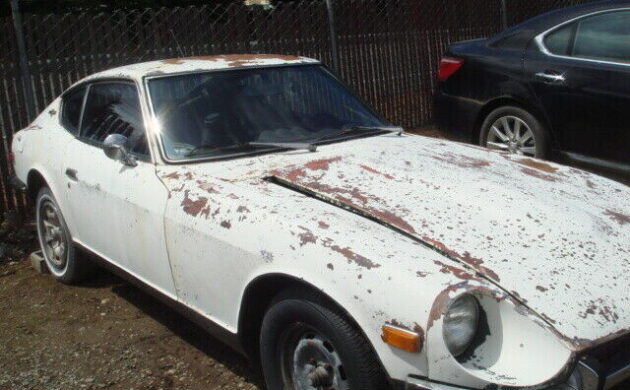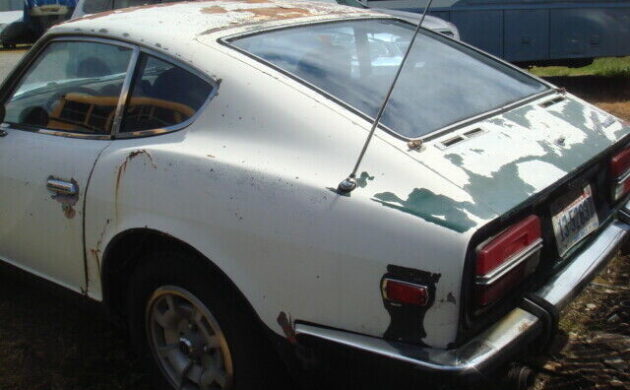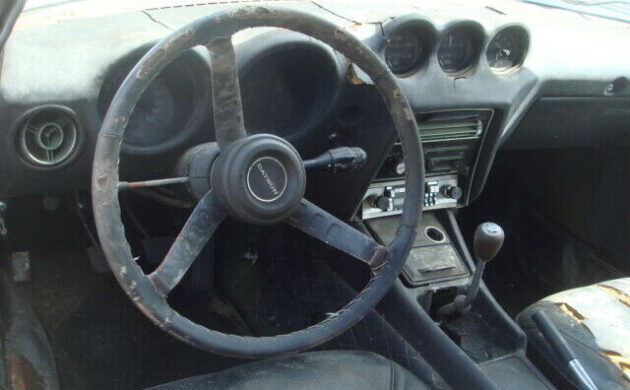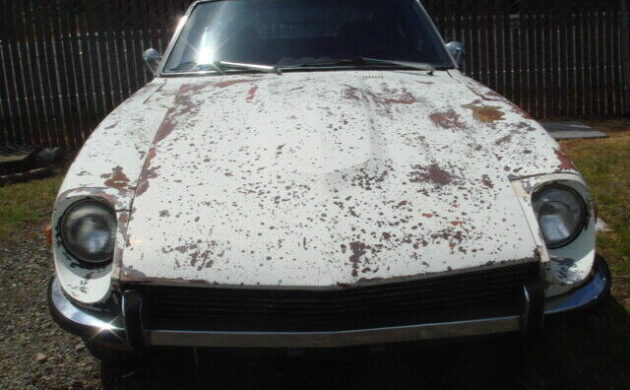With less than two days to go on the countdown clock at the time of publishing this write-up, there is some urgency if you’re into early production Z cars. On offer is a 1970 Series 1 240Z — VIN HLS30-06256. Using the decoder over at the Datsun Z Club, the H is the L24 engine, L is left-hand drive, S30 is the model and that makes this car number 6,256 off the production line. As you can gather from the pictures, it’s a project and the seller claims it not only has its original engine, transmission, and interior but also title paperwork. You can find it here on eBay with the bid sitting at $3,750.
At this point, it would be easy to wax on about how the 240Z put Datsun (Nissan) in the hearts and minds of American sports car enthusiasts, helping the company overcome its image of cheap and cheerful cars (that’s definitely true). Or that the 240Z was Datsun’s answer to Toyota’s 2000GT. (Kinda true, yes.) But really, the S30 is the Japanese ground zero for the combination of great looks, great performance, and hyper-competitive pricing. The car’s MSRP in 1970 according to the NADA archives was $3,526 — the equivalent today of just over $26,000. There aren’t many new cars available for that little money that can deliver what was (at the time, anyway) a slew of bona fide standard performance equipment: four-wheel independent suspension, front disc brakes, twin Hitachi SU-type carbs, quick(ish) ratio steering with 2.7 turns lock-to-lock and a 151hp inline-6. Zero-to-60mph was in the 8-second range, with a top speed around 125mph — definitely no slouch.
From the photos, the car is white but there is green peeking through on the rear hatch and other areas under the hood. A pic of the color code tag isn’t quite legible, but it looks like it might be stamped ‘907’ which, if true, confirms this car rolled off the line wearing Racing Green. Hard to argue with a factory color so evocative of sports and performance cars. To my mind, that’s a genuine bonus.
The seller is pretty candid in his short but concise write-up. He reports that the car sat outside for 25 years and there’s rust. Lots of rust. He does have a sense of humor, too: the battery box (by some miracle) is actually solid, he says. As would be expected, the interior has been ravaged by UV and weather. But it’s original. That’s something, right?
Embarking on this journey is not for the faint of heart, that’s for certain. On the plus side, the finished product could be worth some serious moolah, bearing in mind the many headaches and bloodied knuckles it will take to get this 240Z to Hagerty Concours condition. That effort would, however, make this car worth about $100,000. Who’s up for it?







Original paperwork is a huge advantage for the new owner to use. But, mam it will take some more work to get it up to standards.
If these things are worth $100k, then I’m living in an alternate universe.
Terrible car. Terrible
Needs a lot of love….. may be encroaching on that $100k in a proper restoration….
Talk about “Getting upside down”.
I was part owner of a restoration shop back in the 1980’s. Whenever any 240,260 or 280 Z Car would come in the door for estimating we’d put the car up on the lift and get the screwdrivers and ice picks out and start stabbing the unibody subframe in as many places as possible.
Any one of those cars that have this much visible rust would likely have not even made it to the lift as those cars and this one as well would have required full disassembly dipping or blasting and at that point have huge chunks of the subframe/body pans cut away and replaced. I think that we only did that much with two cars one of which we had to acquire a mechanic’s lien on the title due to the huge amount of money owed and not received.
Cars that are this far gone are notorious for either dropping the engine onto the ground at speed after a good dip in the road or pothole, having the front suspension self destruct and detach itself from the Swiss cheese subframe or the whole front clip moving inches away from the body….
So
Don’t go near this thing.
That’s good advice, the subframes of these cars were notorious for rotting out.
I got a 100,000 miles out of the used one I bought, which had 95K miles on it already. Got back what I paid for it + the patch & repaint costs when I got rid of it in the late 1980’s.
These cars were a lot of fun to drive. Went from muscle cars into a 1979 280ZX 5 speed, straight 6. First year for the ZX…bought it for $900, which included 2 new fenders still in their boxes, which were simple to bolt on.
Had the whole thing restored while on vacation, complete with Whale’s tail
and rear window louvers. Everything got Silver clearcoat. It was super sharp.
As a 10 yo youngster , i saw these all over our canadian roads but sadly not for very long , the tin worm got to them and they really melted away
In no time , they littered parkings , parking lots , backyards and eventually made it to the scrap yard and i guess they came back as cans …
Someone likes it. Sold for 4,550.
I’d like to make a point clear for archival purposes…
I’ve loved and lusted after 240Z’s since 1972.
So I bought a new red one in 1973.
I’d still love to own a CLEAN one too but the prices surpass a much more safer, reliable, faster and better handling Mustang GT as I’ve owned three of them: 2006, 2011 and my current 2020.
I decided to buy that ‘73 when I researched them and found the story about the Datsun engineers had a group of discerning German engineers evaluate the body in white cars in early 1969 only to find that any of the engineers over 6’1” tall could barely fit in the car let alone being able to drive a finished one. So… Datsun immediately redesigned the ergonomics of the cat to accommodate the target market of Europeans and Americans which were the volume markets that Datsun was targeting.
When I came upon that story I decided to drive my ‘67 Fairlane GTA S Code to the Datsun dealer, took a test drive and fell in love.
One final note:
It’s not by accident that Dave on the Motor Trend series “Roadkill” named their 240Z “The Rotsun”.
https://m.youtube.com/watch?v=rhpPg2Lgq5Y